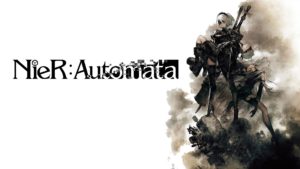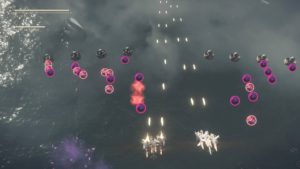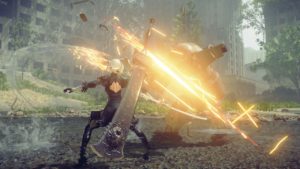
NieR: Automata (PS4 Version)
SPOILER ALERT: THIS POST CONTAINS SPOILERS FOR THE AFOREMENTIONED GAME! READ ON AT YOUR OWN RISK!
NieR: Automata is an action role-playing video game developed by PlatinumGames. It was released in Japan in February 2017 and worldwide the following month.
NieR: Automata is set in a war-ravaged Earth where mankind has evacuated the planet whilst waiting for their created “androids” to reclaim the planet for them against invading alien “machines”. Players take on the roles of three androids, a combat model, 2B, a scout model, 9S, and a rogue prototype, A2. The game makes use of the Rashomon effect to tell the full story of the game.
NieR: Automata was directed by series creator Yoko Taro, produced by Yosuke Saito, composed by Keiichi Okabe and Keigo Hoashi, with Akihiko Yoshida in helming character design.
Elemental Tetrad – Mechanics

NieR: Automata has a unique game mechanic due to the daring move by the game designers to combine two genres of gameplay, namely “Shoot em up” and “Hack and Slash”. When the game first starts players are introduced to the “Shoot em up” section of the game. Players get a top down view of the protagonist, 2B, in her flight unit as she dodges incoming lasers and takes down enemies with the flight unit’s machine guns.
After a short cutscene, the flight unit transforms allowing for movement and shooting in all directions. This also allows for enemies to engage the players from all four sides of the screen. Up until now, the game is played in 2-Dimensional space.

Finally, when 2B is forced to land, the game transitions into the “Hack and Slash” genre, allowing players to play the game in a 3-Dimensional space, with greater focus on button mashing melee combat and perfectly timed dodges than shooting.
The game transitions smoothly between these two genres throughout, occasionally relying on cutscenes to do so, though more commonly by changing the camera viewing angle.
Elemental Tetrad – Story
The story follows the time-tested formula of the Hero’s Journey, very common in JRPGs such as this one. We are introduced into the world of NieR: Automata and see how the characters change with the events that occur. It is a truly emotional experience… But only for those who complete all the side quests as well. As I went through the story, I could understand what the characters were feeling, but I could not feel them myself. I believe I would have grown closer to the characters had I just been able to locate or complete certain side quests before finishing the game. Particularly, the side quests for 2B and 9S support androids, but most importantly the side quest where 9S marks 2B’s grave.
Elemental Tetrad – Aesthetics
NieR: Automata is beautifully designed, with several environments. From the City Ruins to the Desert to the Forest Castle, each of these are a feast for the eyes. Additionally, these environments are populated with their own fauna, giving the world a life of its own. However, what truly sets the mood in NieR: Automata is the accompanying soundtrack. From the peaceful melodies in safe zones, to the choir chanting during a boss fight, it is easy to hear why The Game Awards 2017 gave it “Best Score/Music”.
Elemental Tetrad – Technology
NieR: Automata does not depend heavily on technology. Perhaps the most difficult “tech” implementation would be the smooth transitioning from the 3D Hack and Slash modes of the game to the 2D Shoot em up modes, especially the modes that do not use cutscenes.
Lens of Surprise
NieR: Automata’s surprises come from the revelations in its story. For newcomers to the JRPG genre, the story is packed full of exciting reveals. For long time players of JRPGs they would have come to expect these plot twists, yet the reveals still deliver astonishment from learning new, and often dark, facts about this universe.
Lens of Fun
NieR: Automata stays fun as it breaks repetitive gameplay through its transitions to and from Hack and Slash and Shoot em up modes. This ensures that while you play the same game trying to achieve the same objective, your style of play constantly changes with the game. Each switch kept me engaged to the game, making me more eager to continue to the end, a problem I have with most other JRPGs that require grinding to attain a higher level to take on the boss.
Lens of Curiosity
NieR: Automata places you immediately into the action of a new world and requires you to process information that’s given without much context. All you know is that you are flying towards an objective, and your mission is to destroy the objective. One of the first things players would subconsciously ask themselves is “what is the objective?”. Personally, my variation of this was “what does the objective look like?” When I was attacked a giant metal arm with a buzz saw like structure for a hand, I assumed that was the objective, but this was not the case. It wouldn’t be until I faced a giant robot with two such arms did I truly know what I was supposed to best. Much like the explorers of the 16th Century, I dug around every nook and cranny of this new world and found places that I would have never found if I had purely followed the story.
Lens of Unification Theme
NieR: Automata’s unifying theme encompasses the philosophical questions of life. The androids and machines were created with the sole purpose of fighting the war on the behalf of humans and aliens, but with the creators gone, what purpose do the creations serve? What separates the androids from the machines, when the machines have learnt to have emotions, or even when it is discovered that androids are made from the core of a machine? The story, side quests, and general setting for the game brilliantly come together to make us question this.
